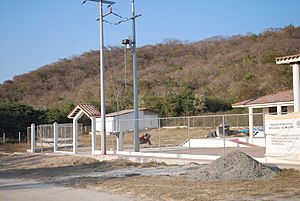Xihuacan facts for kids

Site museum
|
|
| Location | La Soledad de Maciel, Mexico |
|---|---|
| Coordinates | 17°31′00″N 101°19′00″W / 17.51667°N 101.31667°W |
| Type | Archeology |
| History | |
| Founded | 800 BC |
| Abandoned | 300 AD |
Xihuacan is an ancient archaeological site in Mexico. It's located in the state of Guerrero, near the town of La Soledad de Maciel. This site was once home to different Mesoamerican cultures. People lived here for over 3,000 years!
Archaeologists have found many interesting things at Xihuacan. These include a very large Mesoamerican ball court and a huge pyramid base. There's also a hill with ancient rock carvings called petroglyphs. The site shows that people here had connections with other important cultures, like the Teotihuacan and Olmec.
Contents
Discovering Xihuacan's Past
People living in the area found ancient objects since the 1930s. Some very important pieces were among these early finds. Official archaeological digs only started around 2007. This was when the government began buying land for exploration.
Important Finds and Their Journey
One special discovery was a large stone carving called the King of La Chole. It was found in 1944 and was a very respected figure. Today, this carving is kept safe in the local church.
Other important items were the rings from the ancient ball court. A round stone representing the Earth goddess, Tlaltecutli, was also found. These items were moved to a museum at the site. The King of La Chole carving, however, remains at the church.
Where is Xihuacan Located?
The Xihuacan site is in the small village of La Soledad de Maciel. This village is part of the Petatlán municipality. It's about 4 kilometers (2.5 miles) south of Highway 200.
The Village and Its Economy
La Soledad de Maciel is a small community. Its residents mostly farm corn, beans, and coconuts. They also raise some cattle and fish along the coast. The area is also known for growing tobacco and making handmade cigars.
Why Xihuacan is Important
From 2007 to 2010, a museum was built at the site. This project helped study and protect the ruins. It also created a new tourist attraction for the area.
Experts believe Xihuacan could be as important as famous sites like Teotihuacan. It covers a long period of Mesoamerican history. It is the largest ceremonial center and archaeological site in the state of Guerrero.
Ancient City of Xihuacan
The site matches the ancient city of Xihuacan. This city was very important between 200 and 800 CE. At its peak, it was the biggest city between Acapulco and Zacatula.
Connections with Other Cultures
The excavated site was likely a ceremonial center. Different cultures used it over time, including the Tomiles and Cuitatecos. The site might have stretched over 10 square kilometers (3.8 square miles).
Archaeologists found ceramics and other objects. These show that Xihuacan had strong ties with other Mesoamerican cultures. They traded goods and shared ideas with places like Teotihuacan. An idol found at the site, 1.5 meters (5 feet) tall, seems to be from the ancient Olmec period.
Exploring the Main Areas
Archaeologists have explored several key areas at Xihuacan. These include Mound A, Mound B, and the Cerro de los Brujos.
Mound A: The Ball Court
Mound A is where the ancient ball court is located. This court is about 160 meters (525 feet) long and 29 meters (95 feet) wide. There's still more to uncover, which could make it the largest Mesoamerican ball court ever found.
During the excavation, archaeologists found human sacrifices and jaguar-shaped ceramics. They also found a special symbol, or glyph. This glyph is thought to be related to the city's original name.
Mound B: The Pyramid Base
Mound B is a large pyramid base. It measures about 1 hectare (2.5 acres) and is 15 meters (49 feet) high. Five temples once stood on top of this mound. They surrounded a sunken patio area.
Cerro de los Brujos: Hill of Carvings
The Cerro de los Brujos, or "Hill of the Sorcerers," has many petroglyphs. These are ancient carvings on rocks. There's also a circular stone that might have been used for sacrifices. Four smaller pyramid bases are also found on this hill.
One unique thing about Xihuacan is how its pyramids were built. They used river stones and adobe bricks. This was not a common building method in other ancient Mexican sites.
See also
 In Spanish: La Soledad de Maciel para niños
In Spanish: La Soledad de Maciel para niños

